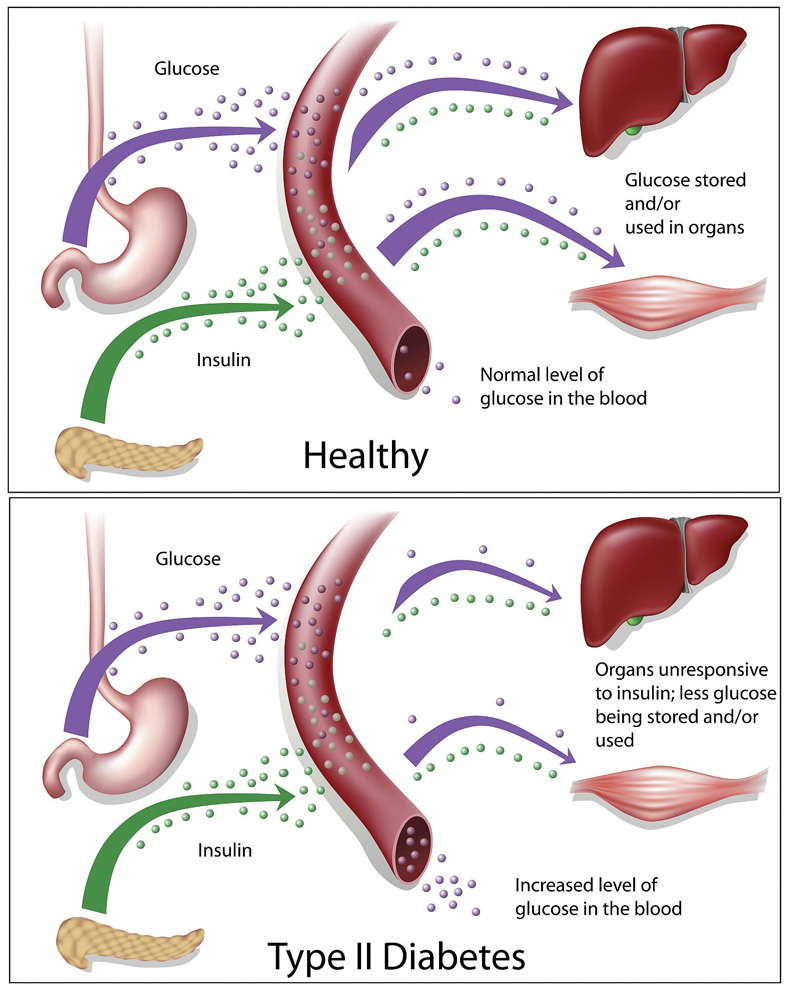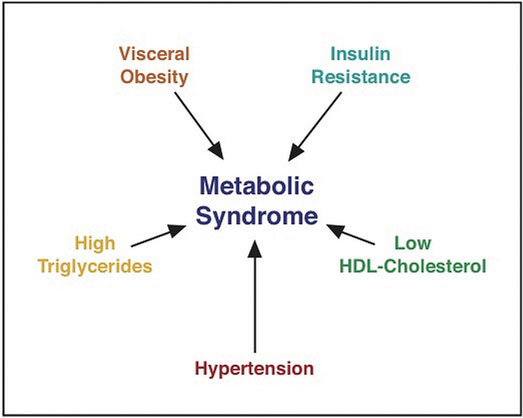Chapter 4. Carbohydrates
Diabetes
Diabetes
What Is Diabetes?
Diabetes affects millions of people young and old and causes tens of thousands of deaths each year. Diabetes is a metabolic disease of insulin deficiency and glucose over-sufficiency. Like other diseases, genetics, nutrition, environment, and lifestyle are all involved in determining a person’s risk for developing diabetes. One sure way to decrease your chances of getting diabetes is to maintain an optimal body weight by adhering to a diet that is balanced in carbohydrate, fat, and protein intake. There are three different types of diabetes: Type 1 diabetes, Type 2 diabetes, and gestational diabetes.
Type 1 Diabetes
Type 1 diabetes is a metabolic disease in which insulin-secreting cells in the pancreas are killed by an abnormal response of the immune system, causing a lack of insulin in the body. Its onset typically occurs before the age of thirty. The only way to prevent the deadly symptoms of this disease is to inject insulin under the skin.
A person with Type 1 diabetes usually has a rapid onset of symptoms that include hunger, excessive thirst and urination, and rapid weight loss. Because the main function of glucose is to provide energy for the body, when insulin is no longer present there is no message sent to cells to take up glucose from the blood. Instead, cells use fat and proteins to make energy, resulting in weight loss. If Type 1 diabetes goes untreated individuals with the disease will develop a life-threatening condition called ketoacidosis. This condition occurs when the body uses fats and not glucose to make energy, resulting in a build-up of ketone bodies in the blood. It is a severe form of ketosis with symptoms of vomiting, dehydration, rapid breathing, and confusion and eventually coma and death. Upon insulin injection these severe symptoms are treated and death is avoided. Unfortunately, while insulin injection prevents death, it is not considered a cure. People who have this disease must adhere to a strict diet to prevent the development of serious complications. Type 1 diabetics are advised to consume a diet low in the types of carbohydrates that rapidly spike glucose levels (high-GI foods), to count the carbohydrates they eat, to consume healthy-carbohydrate foods, and to eat small meals frequently. These guidelines are aimed at preventing large fluctuations in blood glucose. Frequent exercise also helps manage blood-glucose levels. Type 1 diabetes accounts for between 5 and 10 percent of diabetes cases.
Type 2 Diabetes
The other 90 to 95 percent of diabetes cases are Type 2 diabetes. Type 2 diabetes is defined as a metabolic disease of insulin insufficiency, but it is also caused by muscle, liver, and fat cells no longer responding to the insulin in the body (Figure 4.10 “Healthy Individuals and Type 2 Diabetes” . In brief, cells in the body have become resistant to insulin and no longer receive the full physiological message of insulin to take up glucose from the blood. Thus, similar to patients with Type 1 diabetes, those with Type 2 diabetes also have high blood-glucose levels.
Figure 4.10 Healthy Individuals and Type 2 Diabetes

For Type 2 diabetics, the onset of symptoms is more gradual and less noticeable than for Type 1 diabetics. The first stage of Type 2 diabetes is characterized by high glucose and insulin levels. This is because the insulin-secreting cells in the pancreas attempt to compensate for insulin resistance by making more insulin. In the second stage of Type 2 diabetes, the insulin-secreting cells in the pancreas become exhausted and die. At this point, Type 2 diabetics also have to be treated with insulin injections. Healthcare providers is to prevent the second stage from happening. As with Type 1 diabetes, chronically high-glucose levels cause big detriments to health over time, so another goal for patients with Type 2 diabetes is to properly manage their blood-glucose levels. The front-line approach for treating Type 2 diabetes includes eating a healthy diet and increasing physical activity.
Genetics, environment, nutrition, and lifestyle all play a role in determining a person’s risk for Type 2 diabetes. We have the power to change some of the determinants of disease but not others. The Diabetes Prevention Trial that studied lifestyle and drug interventions in more than three thousand participants who were at high risk for Type 2 diabetes found that intensive lifestyle intervention reduced the chances of getting Type 2 diabetes by 58 percent.[1]
Gestational Diabetes
During pregnancy some women develop gestational diabetes. Gestational diabetes is characterized by high blood-glucose levels and insulin resistance. The exact cause is not known but does involve the effects of pregnancy hormones on how cells respond to insulin. Gestational diabetes can cause pregnancy complications and it is common practice for healthcare practitioners to screen pregnant women for this metabolic disorder. The disorder normally ceases when the pregnancy is over, but the National Diabetes Information Clearing House notes that women who had gestational diabetes have between a 40 and 60 percent likelihood of developing Type 2 diabetes within the next ten years.[2] Gestational diabetes not only affects the health of a pregnant woman but also is associated with an increased risk of obesity and Type 2 diabetes in her child.
Prediabetes
As the term infers, prediabetes is a metabolic condition in which people have moderately high glucose levels, but do not meet the criteria for diagnosis as a diabetic. Individuals with prediabetic are at increased risk for Type 2 diabetes and cardiovascular disease. The National Diabetes Information Clearing House reports that 35 percent of adults aged twenty and older, and 50 percent of those over the age of sixty-five have prediabetes.[2]
Prevalence and Long-Term Health Consequences of Diabetes
The Public Health Agency of Canada (PHAC) estimates that as of 2013-2014, about 3 million Canadians have diagnosed diabetes, which is 8.1 percent of the population.[3] Additionally, approximately 1 in 300 children and youth (1–19 years), and 1 in 10 adults (20 years and older) are living with diabetes in Canada and the numbers are expected to increase in coming years.[3]
The long-term health consequences of diabetes are severe. They are the result of chronically high glucose concentrations in the blood accompanied by other metabolic abnormalities such as high blood-lipid levels. People with diabetes are between two and four times more likely to die from cardiovascular disease. Diabetes is the number one cause of new cases of blindness, lower-limb amputations, and kidney failure. Many people with diabetes develop peripheral neuropathy, characterized by muscle weakness, loss of feeling and pain in the lower extremities. More recently, there is scientific evidence to suggest people with diabetes are also at increased risk for Alzheimer’s disease.
Diabetes Treatment
Keeping blood-glucose levels in the target range (70–130 mg/dL before a meal) requires careful monitoring of blood-glucose levels with a blood-glucose meter, strict adherence to a healthy diet, and increased physical activity. Type 1 diabetics begin insulin injections as soon as they are diagnosed. Type 2 diabetics may require oral medications and insulin injections to maintain blood-glucose levels in the target range. The symptoms of high blood glucose, also called hyperglycemia, are difficult to recognize, diminish in the course of diabetes, and are mostly not apparent until levels become very high. The symptoms are increased thirst and frequent urination. Having too low blood glucose levels, known as hypoglycemia, is also detrimental to health. Hypoglycemia is more common in Type 1 diabetics and is most often caused by injecting too much insulin or injecting it at the wrong time. The symptoms of hypoglycemia are more acute including shakiness, sweating, nausea, hunger, clamminess, fatigue, confusion, irritability, stupor, seizures, and coma. Hypoglycemia can be rapidly and simply treated by eating foods containing about ten to twenty grams of fast-releasing carbohydrates. If symptoms are severe a person is either treated by emergency care providers with an intravenous solution of glucose or given an injection of glucagon, which mobilizes glucose from glycogen in the liver. Some people who are not diabetic may experience reactive hypoglycemia. This is a condition in which people are sensitive to the intake of sugars, refined starches, and high GI foods. Individuals with reactive hypoglycemia have some symptoms of hypoglycemia. Symptoms are caused by a higher than normal increase in blood-insulin levels. This rapidly decreases blood-glucose levels to a level below what is required for proper brain function.
The major determinants of Type 2 diabetes that can be changed are overnutrition and a sedentary lifestyle. Therefore, reversing or improving these factors by lifestyle interventions markedly improve the overall health of Type 2 diabetics and lower blood-glucose levels. In fact it has been shown that when people are overweight, losing as little as nine pounds (four kilograms) decreases blood-glucose levels in Type 2 diabetics. The Diabetes Prevention Trial demonstrated that by adhering to a diet containing between 1,200 and 1,800 kilocalories per day with a dietary fat intake goal of less than 25 percent and increasing physical activity to at least 150 minutes per week, people at high risk for Type 2 diabetes achieved a weight loss of 7 percent and significantly decreased their chances of developing Type 2 diabetes.[4]
Diabetes Canada has a website that provides information and tips for helping individuals with diabetes manage their condition including dietary practices to help keep blood-glucose levels in the target range: https://www.diabetes.ca
Figure 4.12 Metabolic Syndrome: A Combination of Risk Factors Increasing the Chances for Chronic Disease

Having more than one risk factor for Type 2 diabetes substantially increases a person’s chances for developing the disease. Metabolic syndrome refers to a medical condition in which people have three or more risk factors for Type 2 diabetes and cardiovascular disease. According to the International Diabetes Federation (IDF) people are diagnosed with this syndrome if they have central (abdominal) obesity and any two of the following health parameters: triglycerides greater than 150 mg/dL; high density lipoproteins (HDL) lower than 40 mg/dL; systolic blood pressure above 100 mmHg, or diastolic above 85 mmHg; fasting blood-glucose levels greater than 100 mg/dL.[5] The IDF estimates that between 20 and 25 percent of adults worldwide have metabolic syndrome. Studies vary, but people with metabolic syndrome have between a 9 and 30 times greater chance for developing Type 2 diabetes than those who do not have the syndrome.[5]
- Knowler WC. Reduction in the Incidence of Type 2 Diabetes with Lifestyle Intervention or Metformin. The New England Journal of Medicine. 2002; 346(6), 393–403. http://www.nejm.org/doi/full/10.1056/NEJMoa012512. Accessed April 15, 2018. ↵
- Diabetes Overview. National Institute of Diabetes and Digestive and Kidney Disease. https://www.niddk.nih.gov/health-information/diabetes/overview. Accessed April 15, 2018. ↵
- Public Health Agency of Canada (PHAC). Diabetes in Canada: Highlights from the Canadian Chronic Disease Surveillance System. Ottawa (ON): PHAC; 2017 [cited 2017 July 7]. Available from:Diabetes Research and Statistics.Centers for Disease Control and Prevention. https://www.canada.ca/en/public-health/services/publications/diseases-conditions/diabetes-canada-highlights-chronic-disease-surveillance-system.html. Accessed June 30, 2019. ↵
- Knowler WC. Reduction in the Incidence of Type 2 Diabetes with Lifestyle Intervention or Metformin. The New England Journal of Medicine. 2002; 346(6), 393–403. http://www.nejm.org/doi/full/10.1056/NEJMoa012512. Accessed April 15, 2018. ↵
- The IDF Consensus Worldwide Definition of the Metabolic Syndrome. International Diabetes Federation.https://www.idf.org/our-activities/advocacy-awareness/resources-and-tools/60:idfconsensus-worldwide-definitionof-the-metabolic-syndrome.html. Accessed April 15, 2018. ↵

